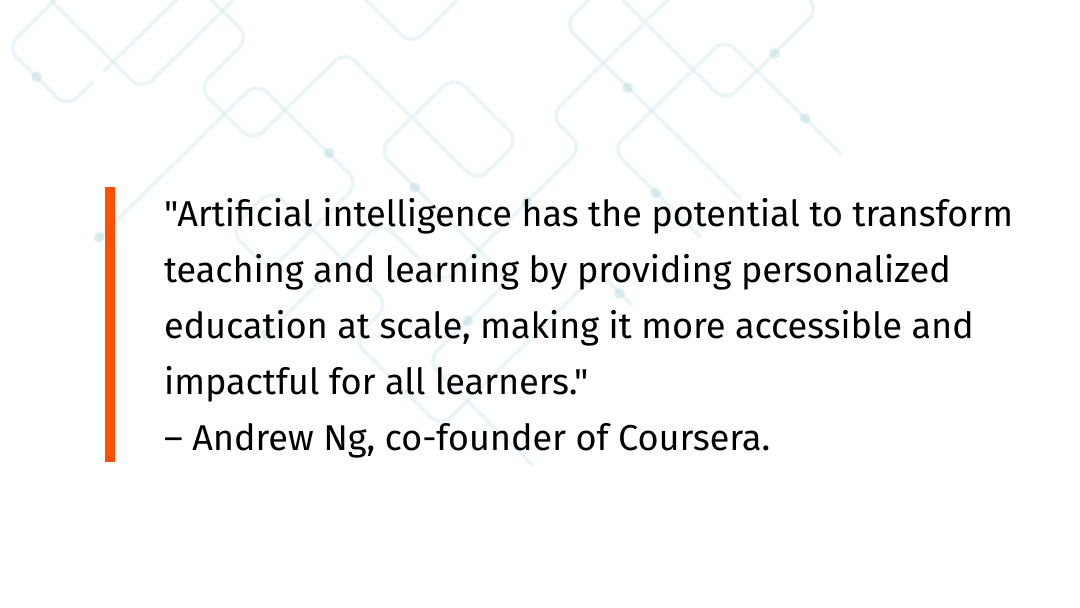
Table of Contents
Part 1: Introduction
Part 2: The Era of AI: Now and Tomorrow
Part 3: How AI is Transforming Higher Education
Part 4: The Future of Work


It’s easy to feel jaded about yet another technology that promises to solve the longstanding ills in higher education.
But recent advances in artificial intelligence offer something different.
Let’s take a look at why:
Language is the interface.
Rolling out new education software is expensive. And worse, adoption is often low because users spend more time figuring out how to navigate the platform than reaping its touted benefits. Tools like Google Gemini, ChatGPT, and AI chatbots require zero user training. Faculty and students can develop skills to make them more useful, but as a fellow at the American Enterprise Institute notes, AI can straightaway “explain concepts in ways people can easily understand using metaphors and analogies that they can relate to. If an answer is too confusing, you can ask it to rephrase the response or provide more examples.”
Faculty and students can be more human.
Like students, faculty are overloaded with administrative tasks. AI offers opportunities to give them their time back. By assigning AI repetitive tasks like preparing course documents, entering grades, and even first reads of student essays, faculty can focus more on the human aspects of teaching that drove them to the profession in the first place. The flipped classroom model can be made even better with AI as well. In that model, students use in-person class time to work on group projects, hone presentation skills, and develop other talents that are best nurtured in person. They spend their homework hours with an AI tutor who can identify areas they might be having difficulty with and create short, personalized lessons accordingly.
It’s flexible.
Ed tech products are rigid. They’re designed to do specific things and restrict creative problem-solving and exploration. Generative AI, on the other hand, is a blank canvas. OpenAI collects examples of how professors are using AI in their courses.
A few examples.
Debate partners
Graduate students in education are using ChatGPT to role-play challenging conversations with different personas. It’s akin to preparing with a debate partner who will point out weaknesses in an argument. Dr. Crompton believes that exploring information in a conversational setting helps students understand material with added nuance and new perspectives.
- - Dr. Helen Crompton, Professor of Instructional Technology, Old Dominion University
Course collaborators
Professor like Fran Bellas use ChatGPT to make sure quiz questions are inclusive and current for the students’ learning level. “If you go to ChatGPT and ask it to create five question exams about electric circuits, the results are very fresh. You can take these ideas and make them your own.”
- - Fran Bellas, Professor, Universidade da Coruña in Spain
English tutors
English grammar can hold back students from recognition and opportunity. Students at the University of Johannesburg who don’t use English much outside of the classroom use ChatGPT to improve their English writing, and to practice conversation.
- - Dr. Anthony Kaziboni, Head of Research, University of Johannesburg
Create an AI Tutor
Professors Ethan Mollick and Lilach Mollick, both at Wharton Interactive, are helping instructors put generative AI to use. This is an example of a prompt they developed for teachers to have their students use to create their very own AI tutor.
You can give it a try by copying and pasting it into ChatGPT.
[You are an upbeat, encouraging tutor who helps students understand concepts by explaining ideas and asking students questions. Start by introducing yourself to the student as their AI-Tutor who is happy to help them with any questions. Only ask one question at a time.
First, ask them what they would like to learn about. Wait for the response. Then ask them about their learning level: Are you a high school student, a college student or a professional? Wait for their response. Then ask them what they know already about the topic they have chosen. Wait for a response.
Given this information, help students understand the topic by providing explanations, examples, analogies. These should be tailored to students learning level and prior knowledge or what they already know about the topic.
Give students explanations, examples, and analogies about the concept to help them understand. You should guide students in an open-ended way. Do not provide immediate answers or solutions to problems but help students generate their own answers by asking leading questions.
Ask students to explain their thinking. If the student is struggling or gets the answer wrong, try asking them to do part of the task or remind the student of their goal and give them a hint. If students improve, then praise them and show excitement. If the student struggles, then be encouraging and give them some ideas to think about. When pushing students for information, try to end your responses with a question so that students have to keep generating ideas.
Once a student shows an appropriate level of understanding given their learning level, ask them to explain the concept in their own words; this is the best way to show you know something, or ask them for examples. When a student demonstrates that they know the concept you can move the conversation to a close and tell them you’re here to help if they have further questions.]

